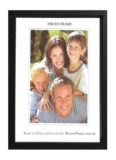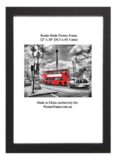The main difference between custom-made and ready-made picture frames is the price. Custom picture frames are made one at a time, usually with better-quality materials, to exactly suit and fit customer's artwork. Both labour and materials cost more so the price will be higher. Ready-made picture frames on the other hand, are produced in mass, often with common-quality materials, to approximately suit the 20 or so most common picture framing sizes. With regard to custom frames, the framer chooses each component of acustom picture frame individually and customizes it according to the customer's instructions.
at a time, usually with better-quality materials, to exactly suit and fit customer's artwork. Both labour and materials cost more so the price will be higher. Ready-made picture frames on the other hand, are produced in mass, often with common-quality materials, to approximately suit the 20 or so most common picture framing sizes. With regard to custom frames, the framer chooses each component of acustom picture frame individually and customizes it according to the customer's instructions.
The customer has probably chosen a specific frame (moulding) which can be wood or metal, and also glazing backing, matting and even hardware. Glazing (the process of covering something with a material) can be bought in several varieties including clear glass, non-reflective and ultra-violet (UV) light reducing. The backing materials, or the materials that the artwork is backed and mounted on, maybe standard, acid free, and self-adhesive options.
For matting, there are hundreds of colours and conservation grades to choose from though several mats maybe used for a truly distinctive look. Because made to the customer’s unique specifications, custom frames are more expensive than ready-made frames and often require a week or more to make. A custom frame usually costs $100 or more. Lastly, as every custom picture frame part needs to be selected individually, the time required to make such a frame package is quite time-consuming and it can easily take up to an hour to complete the whole process. With regard to Ready-Made frames, these are bulk-produced to one of several standard sizes.
These may be the European "A" series sizes such as the ubiquitous A4 printer copy paper, or the common sizes of photography prints (e.g. 4 x 6", 8 x 10", or 16 x 20" ). As these are photo framing industry sizes. Both labour and materials are cheaper, so the price will be lower. As these are mass produced, the framer does not need to change individual framing components. For instance, the mat colour of a ready-made frame is nearly always a white.
In these frames are usually made from low-cost materials such as plastic, styrene and fibreglass. Such frames often come from low cost labour countries such as Indonesia or China. The reason they cost so much less than their custom made counterparts is because they are produced by (relatively) cheaper labour in very large runs. Therefore manufacturers take advantage of the resulting economies of scale. Ready made frames can be of excellent to very poor quality.
This will depend mostly on the materials used, the precision of the manufacturing equipment employed, and the care taken with packaging and storage. A ready-made picture frame bought at a large retail store, while inexpensive may also be of very poor quality and improperly stored. On the other hand, ready-made frames found at picture framing shops tend to be of better quality. This is probably because a picture framer's Ready-Made picture frames tend to be made with better mouldings, with the mitred corners glued, rather than dry-jointed and are likely to carry the picture framer's business details.
Most Ready-Made frames consist of the picture frame, the glazing ( either clear glass or plastic glass ) the backing, the fastening clips or flexitabs and some type of hanging device, either staked-on picture hangers or D-Ring hangers, or staple cord. Basically, these are large photo frames. All a customer has to do is to open up the back of the frame, insert his or her picture, maybe clean the glass, and hang the picture on the wall. Thank you for reading "What's the main difference between Custom-Made and Ready-Made picture frames?".









There’s an additional and important aspect which needs to be considered when buying ready made photo frames, ready made picture frames or custom picture frames. And that is the mounting. When you buy or order a large photo, print or poster and that is custom framed, chances are that, if it’s a reproduction, it’ll be dry or wet mounted. In other words the artwork will be mounted onto a backing and presses in a special picture framing vacuum or heat press. Either of these will bond the paper to its backing board perfectly flat and permanently. But if you buy any ready-made photo frames or picture frames, it is possible that the art or paper will become "wavy" or ripple under the glass. Now, if you’re framing for your holiday home or your kid’s bedroom or their school artwork, that’s Ok, but if you’re hanging your art in your lounge room, then it won’t look nice and you shouldn’t do it.
Cheap ready made picture frames are a lifesaver to me! I’ve got 3 young kids all into animals, art, graphics, music and rock-and-roll. Every month or so they come asking to frame stuff that they like or they just made. I finally got through to them to only give me stuff in A4, A3, A2 and A1 paper sizes. That way I can stick their art into re-changeable picture frames instead of paying through the nose for expensive custom picture frames!
Ready made picture frames are even cheaper when they’re from China rather than Australia. We have a family movie room with several movie posters on walls which we buy from overseas. They’re all 70x100cm, a common poster size. The prices for picture framing them? Melbourne custom-made frames $164 each, Aussie made ready-made frames $99 each and imported Chinese picture frames, $45 each. When you’ve got 14 posters to frame, which of these 3 framing options do you thing most, if not everyone, people would choose? As for making stuff in Australia so as to keep jobs in Australia, well, yes we would choose to do that if the cost wasn’t MORE THAN 3 TIMES than the imported frames !!!!! WE ARE WE SO EXPENSIVE !!!!
Your blog provides an excellent breakdown of the differences between custom-made and ready-made picture frames. The detailed comparison makes it easy to understand which option suits various needs. I especially appreciate how you highlighted the versatility of custom frames for unique artwork. Thanks for this informative post! Keep up the great work in educating readers.